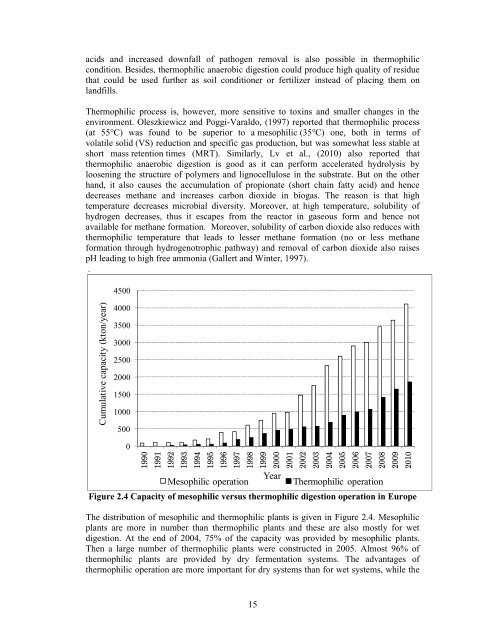dry anaerobic digestion of municipal solid waste and digestate ...
dry anaerobic digestion of municipal solid waste and digestate ...
dry anaerobic digestion of municipal solid waste and digestate ...
You also want an ePaper? Increase the reach of your titles
YUMPU automatically turns print PDFs into web optimized ePapers that Google loves.
acids <strong>and</strong> increased downfall <strong>of</strong> pathogen removal is also possible in thermophilic<br />
condition. Besides, thermophilic <strong>anaerobic</strong> <strong>digestion</strong> could produce high quality <strong>of</strong> residue<br />
that could be used further as soil conditioner or fertilizer instead <strong>of</strong> placing them on<br />
l<strong>and</strong>fills.<br />
Thermophilic process is, however, more sensitive to toxins <strong>and</strong> smaller changes in the<br />
environment. Oleszkiewicz <strong>and</strong> Poggi-Varaldo, (1997) reported that thermophilic process<br />
(at 55°C) was found to be superior to a mesophilic (35°C) one, both in terms <strong>of</strong><br />
volatile <strong>solid</strong> (VS) reduction <strong>and</strong> specific gas production, but was somewhat less stable at<br />
short mass retention times (MRT). Similarly, Lv et al., (2010) also reported that<br />
thermophilic <strong>anaerobic</strong> <strong>digestion</strong> is good as it can perform accelerated hydrolysis by<br />
loosening the structure <strong>of</strong> polymers <strong>and</strong> lignocellulose in the substrate. But on the other<br />
h<strong>and</strong>, it also causes the accumulation <strong>of</strong> propionate (short chain fatty acid) <strong>and</strong> hence<br />
decreases methane <strong>and</strong> increases carbon dioxide in biogas. The reason is that high<br />
temperature decreases microbial diversity. Moreover, at high temperature, solubility <strong>of</strong><br />
hydrogen decreases, thus it escapes from the reactor in gaseous form <strong>and</strong> hence not<br />
available for methane formation. Moreover, solubility <strong>of</strong> carbon dioxide also reduces with<br />
thermophilic temperature that leads to lesser methane formation (no or less methane<br />
formation through hydrogenotrophic pathway) <strong>and</strong> removal <strong>of</strong> carbon dioxide also raises<br />
pH leading to high free ammonia (Gallert <strong>and</strong> Winter, 1997).<br />
.<br />
Cumulative capacity (kton/year)<br />
4500<br />
4000<br />
3500<br />
3000<br />
2500<br />
2000<br />
1500<br />
1000<br />
500<br />
0<br />
1990<br />
1991<br />
1992<br />
1993<br />
1994<br />
1995<br />
1996<br />
1997<br />
1998<br />
Figure 2.4 Capacity <strong>of</strong> mesophilic versus thermophilic <strong>digestion</strong> operation in Europe<br />
The distribution <strong>of</strong> mesophilic <strong>and</strong> thermophilic plants is given in Figure 2.4. Mesophilic<br />
plants are more in number than thermophilic plants <strong>and</strong> these are also mostly for wet<br />
<strong>digestion</strong>. At the end <strong>of</strong> 2004, 75% <strong>of</strong> the capacity was provided by mesophilic plants.<br />
Then a large number <strong>of</strong> thermophilic plants were constructed in 2005. Almost 96% <strong>of</strong><br />
thermophilic plants are provided by <strong>dry</strong> fermentation systems. The advantages <strong>of</strong><br />
thermophilic operation are more important for <strong>dry</strong> systems than for wet systems, while the<br />
15<br />
1999<br />
2000<br />
2001<br />
2002<br />
2003<br />
2004<br />
2005<br />
2006<br />
2007<br />
2008<br />
Year<br />
Mesophilic operation Thermophilic operation<br />
2009<br />
2010

















